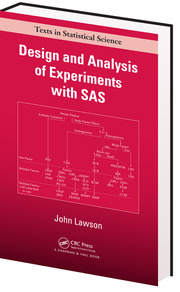Summary
A culmination of the author’s many years of consulting and teaching, Design and Analysis of Experiments with SAS provides practical guidance on the computer analysis of experimental data. It connects the objectives of research to the type of experimental design required, describes the actual process of creating the design and collecting the data, shows how to perform the proper analysis of the data, and illustrates the interpretation of results.
Drawing on a variety of application areas, from pharmaceuticals to machinery, the book presents numerous examples of experiments and exercises that enable students to perform their own experiments. Harnessing the capabilities of SAS 9.2, it includes examples of SAS data step programming and IML, along with procedures from SAS Stat, SAS QC, and SAS OR. The text also shows how to display experimental results graphically using SAS ods graphics. The author emphasizes how the sample size, the assignment of experimental units to combinations of treatment factor levels (error control), and the selection of treatment factor combinations (treatment design) affect the resulting variance and bias of estimates as well as the validity of conclusions.
This textbook covers both classical ideas in experimental design and the latest research topics. It clearly discusses the objectives of a research project that lead to an appropriate design choice, the practical aspects of creating a design and performing experiments, and the interpretation of the results of computer data analysis. SAS code is available on http://lawson.mooo.com and a solutions manual is available for qualifying instructors.
